How to make pickled eggs. A spicy pickled eggs recipe with balsamic and a red beet pickled eggs recipe follow.
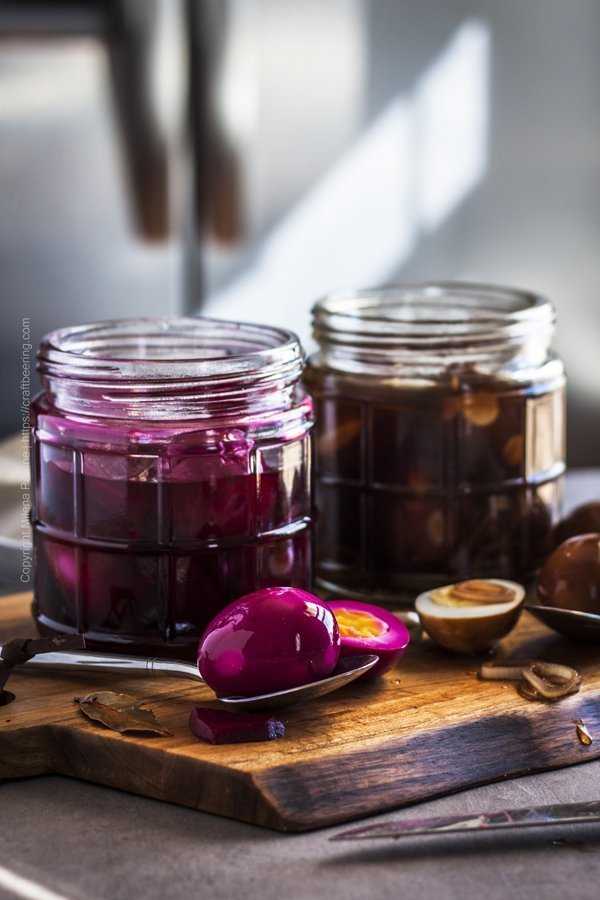
Red beet eggs and balsamic spicy pickled eggs.
Go directly to the Recipe Card or
Read on for relevant information, step-by-step pictures and tips (3 mins).
What are Pickled Eggs?
Pickled eggs enjoy the status of a popular delicacy in Germany, other Northern European countries, Pennsylvania and several other American states.
Pickled means preserved – in brine or vinegar. In the case of eggs the origins point to brine, but later on vinegar began to be added as an additional preservative and flavoring agent.
Hard boiled eggs require a strong saline solution (brine) and from there can be flavored with different vinegars, spices and other ingredients such as garlic, onions, chiles, red cabbage etc.
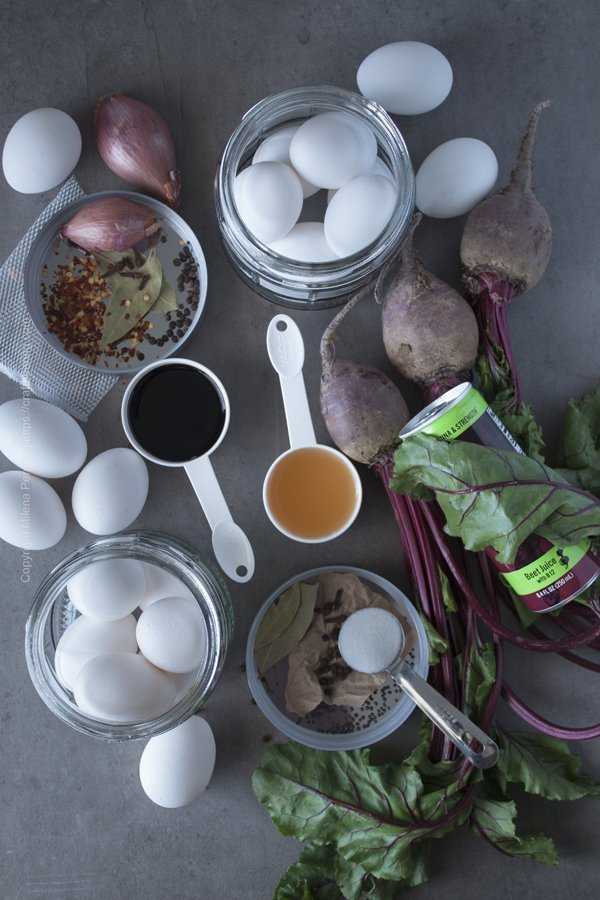
In addition to water and salt, the pickling liquid can be infused with the flavors of shallots, hot red chili pepper flakes, bay leaf, cloves, mustard seeds, beets, balsamic, apple cider vinegar, etc.
How to Make Pickled Eggs?
You can customize this basic pickled eggs recipe to your own taste. Or consider the two popular variations we present below.
Step 1. In a pot or large saucepan hard boil the eggs and peel them. Use the boiling method you believe to work best or refer to ours in the recipe card. If we may suggest – be sure to cool the cooked eggs immediately, if possible in an ice bath in order to make the peeling easier.
Step 2. Boil the water, salt, vinegar and other ingredients in order to dissolve the salt and bring the pickling liquid to temperature (must be used hot). Simmer for five minutes.
At a minimum use 1 1/2 tbsp kosher or sea salt (never iodized) to 2 cups of water (this yields about 5 % brine solution) and 2 cups of vinegar.
You can flavor the brine with whatever you’d like – from mustard seeds and peppercorns to garlic cloves, shallots and tarragon.
Step 3. Arrange the peeled eggs in a large mason jar with a wide mouth (or a similar glass container with an air tight lid). Pour the hot pickling solution over them and immediately close the lid. Refrigerate.
The eggs will be ready to enjoy after two to three days of soaking up the flavors.
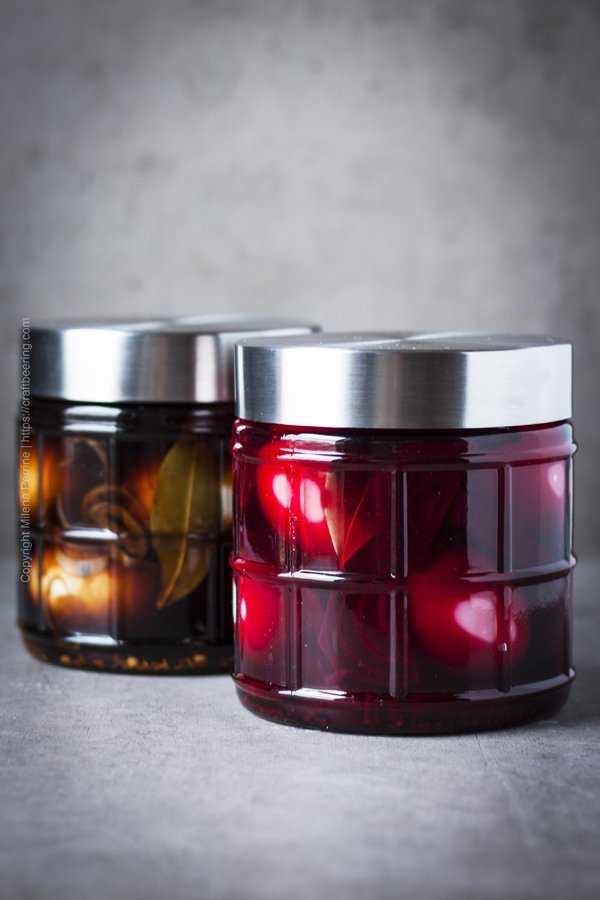
Seal the jars as soon as you pour the hot pickling liquid over the hard boiled eggs.
Pickled Beets and Eggs (aka Red Beet Eggs)
In this very well loved variation both the eggs and the beets are pickled. This could mean an extra step – if using raw beets, you need to boil, peel and slice them. When we do this we add beet juice in the brine. Alternatively, you can use canned beets and use their liquid in lieu of beet juice.
Under this method the eggs take on a gorgeous deep pink color and the earthiness of the beets acquires bright notes from the pickling liquid.
- All you have to do is layer cooked beet slices and hard boiled, peeled eggs in a jar, then pour the hot pickling liquid over them. Just as seen in the image grid below.
Spicy Pickled Eggs
For heat you can use thinly sliced hot peppers such as jalapenos or serrano. Choose a compatible vinegar such as red wine or a white vinegar. We love the combination of hot red pepper flakes, dark balsamic vinegar and shallots – their flavors complement each other really well.
The eggs take on a rich brown color from the balsamic (if space is tight in the jar the spots where the eggs touched the walls or each other will remain white).
- To make these spicy pickled eggs arrange the peeled hard boiled eggs in a jar (you will be able to fit a couple of more relative to the version with beets).
- Boil the water, salt, vinegar, pepper flakes, thinly sliced shallots and spices, simmer them for five minutes and pour the hot liquid mixture over the eggs.
How Long Do Pickled Eggs Last?
Refrigerated they can last for up to three, even four months. While storing them in the fridge you can occasionally move them around the container they are in.
How to Eat Pickled Eggs (and Twists)
There are so many ways to enjoy this delicacy – from simply seasoning the eggs with a bit of salt to slicing them in circles and assembling an open faced sandwich with some mayo and finely chopped green onions.
- You can take bites from a whole egg, with a side of remoulade or you can present the eggs sliced in half lengthwise and top them with capers or thinly sliced red onions and drizzle them with oil and vinegar, like a salad.
- In the case of red beet eggs, serve the sliced eggs along with the beet slices. You can season with salt and pepper, perhaps a drizzle of olive oil.
- Use your favorite deviled eggs recipe or make an egg salad with perhaps some fresh dill sprigs.
- Mustard is an excellent condiment for these. You can either place a dab of mustard onto egg halves or use the method from the German Rhur region where they take an egg half, carefully remove the yolk by scooping it out with a teaspoon and fill the white with spicy mustard, a bit of oil and vinegar. They then eat the egg yolk and quickly chase it with the filled white.
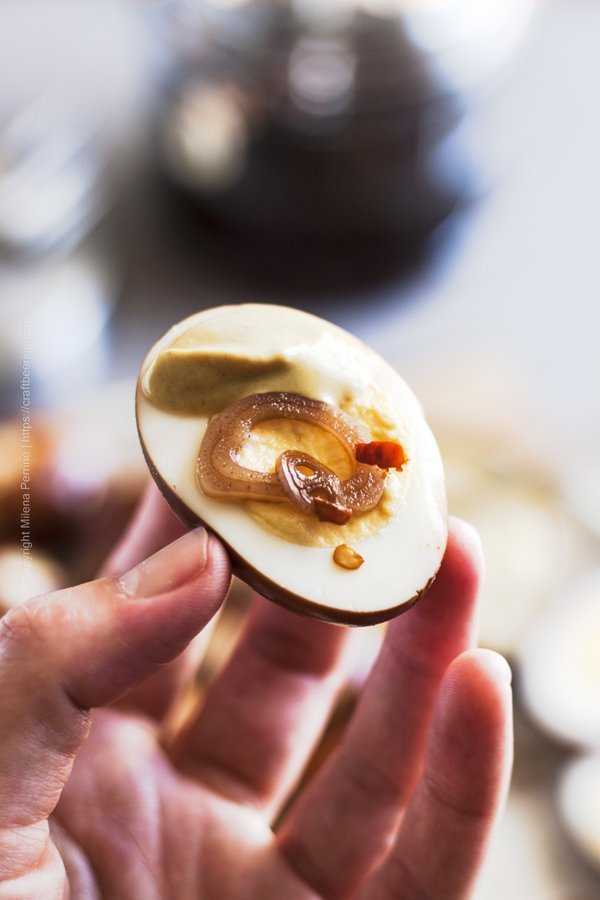
Using slices of pickled shallots and a bit of Dijon mustard makes for a great garnish.
These ideas for twists on pickled egg recipes are worth considering:
- In Germany it is very much the norm to pickle the eggs with the crushed shells on. Individual eggs are later peeled, right before being consumed. This is the way of choice eight out of ten times – just browse German recipes for Soleier and you’ll be convinced. Depending on what other ingredients are used in the pickling liquid this method results in an irregular, webby appearance on the whites’ surface resulting from the colored liquid reaching in through the cracked shells.
- Add your favorite craft beer to the pickling liquid – similarly to these Beer Pickles. A balanced, citrusy IPA or a malty, sweet ale are suitable. Add the beer to the other ingredients of the pickling liquid before bringing them to boil. The alcohol and hops will help preserve the eggs. Use a 1:1:1 ratio of brine, vinegar and beer.
- Use caraway seeds and thinly sliced garlic cloves in the pickling liquid or your favorite pickling spice.
Needless to say – pickled eggs are excellent to pair with beer, especially highly carbonated, hoppy German pilsners or malty English ales.
History
Similarly to other pickled foods hard boiled eggs were first preserved by necessity. In the old days in Europe, before there was refrigeration any time there was a surplus of eggs, people preserved them in brine. A strong saline solution could keep the eggs safe to eat without the need for cooling. Th
Later on they became very popular as bar food, usually offered on a complimentary basis. The dispute about which country originated the tradition remains unsettled. Among the main contenders are Great Britain, France, Germany…
Nowadays pickled eggs are very much alive as a delicacy and in good health as bar food. Most German Kneipen (pubs) and similar establishments in Britain and the Scandinavian countries offer them to bar patrons. A large jar full of them perched on a bar counter is a common sight.
Additionally the eggs are a great picnic food item and their profusion as such in Germany can be observed at most beer gardens with large grounds who allow patrons to bring their own packed picnic baskets. Soleier (as they are called) are sold in grocery stores and frequently made at home.
The hard boiled pickled egg idea was brought to the US by various immigrants from European countries. When they were first offered at American bars as a free bar snack many responded favorably to the delicious protein and the idea took hold. There are many bars in contemporary America that pride themselves on being able to offer the snack to their customers.
Today, you can expect to find the snack in many places around the world where beer is served. They are also an excellent way to do away with Easter eggs – just be sure that they get pickled as soon as possible.
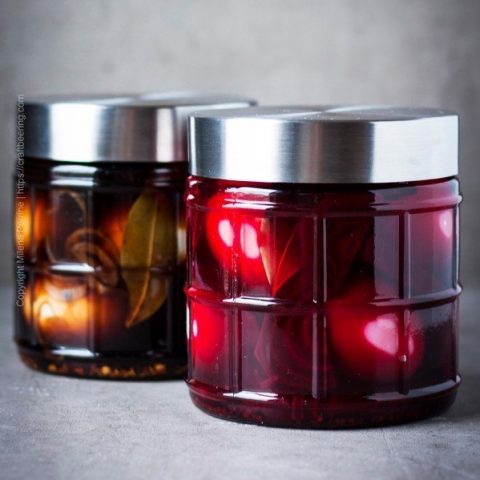
Pickled Eggs (Spicy Balsamic or Beet Pickled)
How to make pickled eggs and vary the basic recipe to suit your own taste preferences. Beet pickled eggs and spicy pickled eggs presented in detail.
Ingredients
For Beet Pickled Eggs
- 10 eggs
- 3 small beets (or 1 can canned beets, reserve liquid in lieu of next ingredient)
- 1 cup apple cider vinegar
- 1/4 cup beet juice
- 3/4 cups water
- 4 tsp kosher or sea salt
- 1 tbsp sugar
- 2 bay leaves
- 1 tsp mustard seeds
- cloves, black peppercorns to taste
For Spicy Pickled Eggs
- 10 eggs
- 1 cup balsamic vinegar
- 1 cup water
- 4 tsp kosher or sea salt
- 1 tbsp hot red pepper flakes (more if you want them to be really spicy)
- 2 shallots, thinly sliced
- 2 bay leaves
- cloves, black peppercorns to taste
Instructions
For Either Version
- Place the eggs in a pot and add cold water until they are submerged. Cover with a lid and bring to boil. Reduce heat to medium and simmer eggs for 10 minutes.
- Place the cooked eggs in an ice bath (or very cold water) to cool them down. Remove the shells by starting at the flatter end.
For Beet Pickled Eggs
- Boil the beets until tender (about 40 mins). Cool off, peel and slice in bite-sized pieces. In a jar with wide mouth or similar container alternate layers of peeled eggs and beet slices.
- Alternatively, strain the beets from a can and reserve the liquid. Layer beets and eggs as described above.
- In a sauce pan bring water, salt, sugar, apple cider vinegar, beet juice (or reserved liquid from can), mustard seeds, cloves, peppercorns, bay leaf to boil. Simmer for five minutes.
- Pour the hot liquid over the peeled eggs and the beets, seal the jar and refrigerate.
For Spicy Pickled Eggs
- Arrange the cooked, peeled eggs in a mason jar or similar container with a wide mouth.
- In a sauce pan bring water, salt, balsamic vinegar, hot red pepper flakes, shallots, cloves, peppercorns, bay leaf to boil. Simmer for five minutes.
- Pour the hot liquid and the shallots over the peeled eggs, seal the jar and refrigerate.
Notes
Never use iodized table salt for pickling - it is not suited for the purpose.
The amount of pickling liquid in this recipe is calibrated for ten eggs. Depending on the size of the container you are using you may have a little bit of liquid leftover (discard) or may be able to fit and completely cover a dozen of boiled eggs.
Both versions of the recipe will give you richly colored outsides, the dark pink pigment from the beets will penetrate the whites all the way through the yolks.
Pickled eggs are ready to eat within two or three days after prepared and will last refrigerated for three to four months.
With time the texture of the whites which pleasantly firms up during the initial days will become more rubbery an take on more flavor.
Nutrition information is noted based on two pickled eggs, not including beets.
Nutrition Information:
Yield: 10Amount Per Serving: Calories: 137Total Fat: 5gSaturated Fat: 2gTrans Fat: 0gUnsaturated Fat: 3gCholesterol: 186mgSodium: 1041mgCarbohydrates: 14gFiber: 1gSugar: 10gProtein: 7g

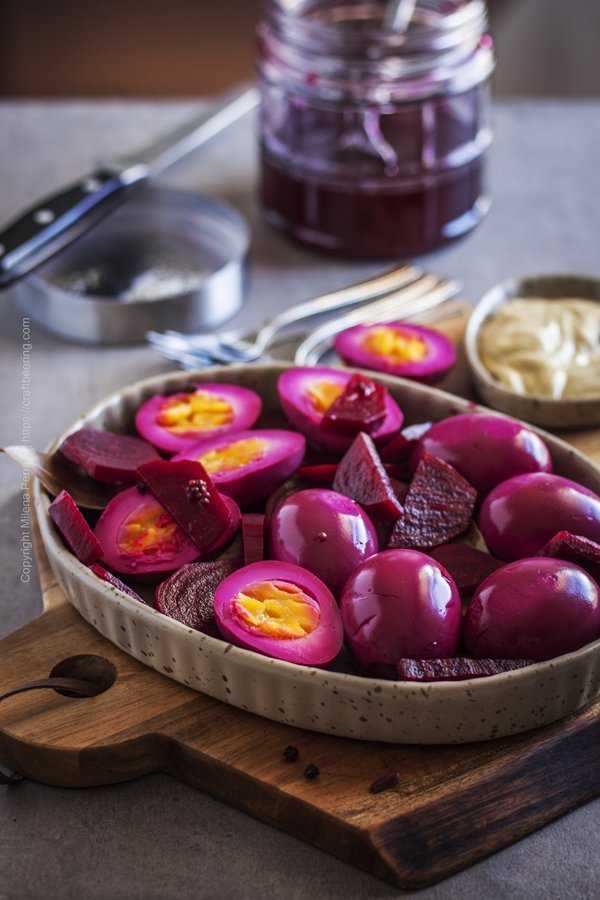
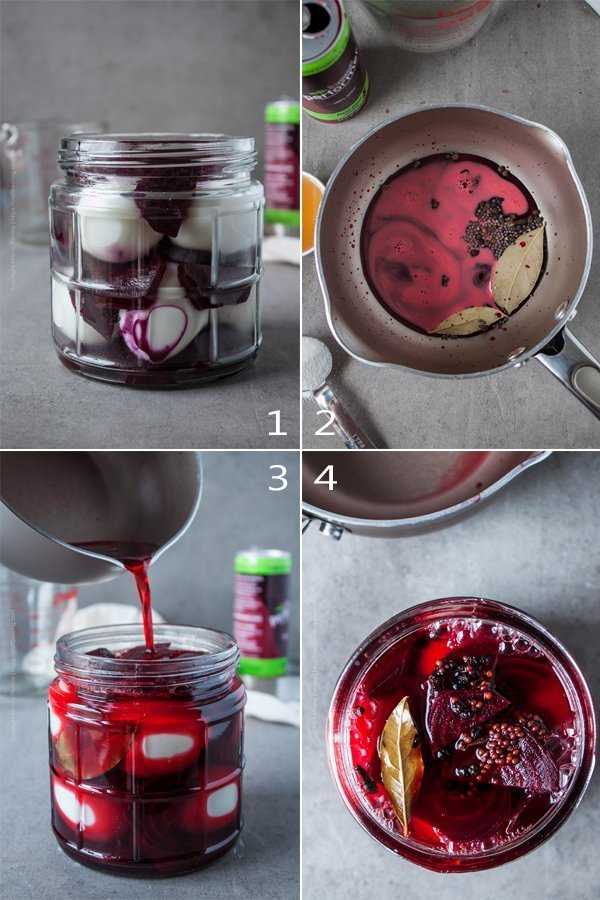
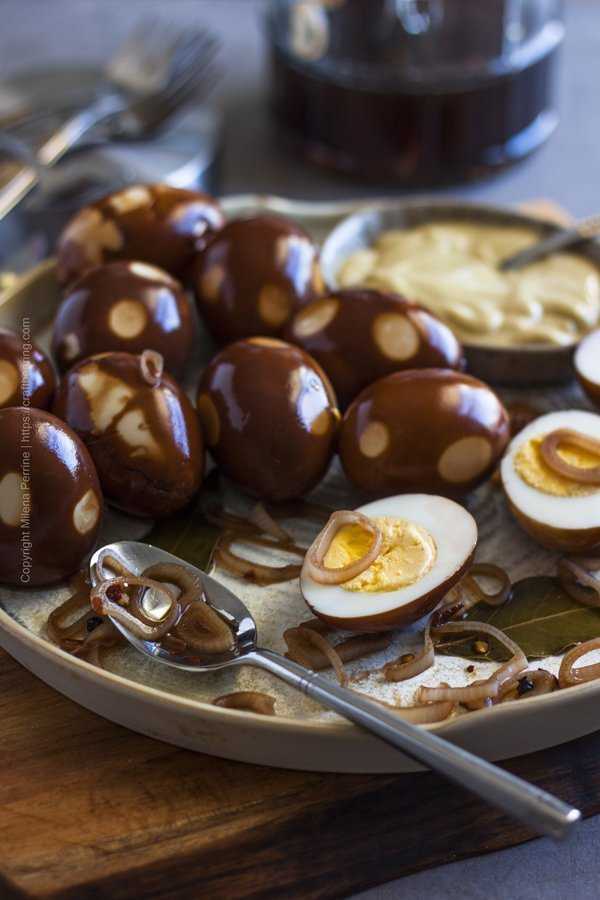
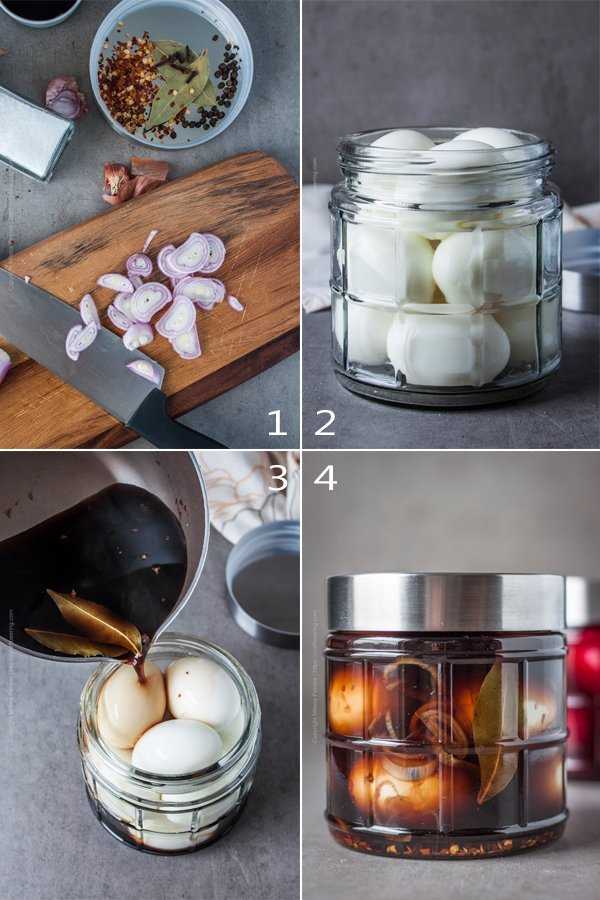
Sherryl L Downing says
my grandson wants the brine to penetrate into the egg yolk, can I do that and how?
Craft Beering says
Sherryl, eventually the pickling liquid (due to the salt it cotains) will reach deep into each egg and reach the yolk. A longer time spent in the brine results in fuller flavor.
Kathy t Kegley says
I like to use McCormick pickling spices in my mixture. Is it OK to put the spices in cheesecloth ? If so, do I leave the bag in the jar indefinitely or do I remove it after they have done their job?
Craft Beering says
Absolutley, you can make a bouquet garni with cheesecloth and leave it in the jar along with the eggs for as long as you like.
KRISTEN says
Hello. Thank you for the recipes. They look awesome. I am making the balsamic eggs and I am confused about the salt. Salt is mentioned in the egg boiling ingredients but not the pickling ingredients. And no salt is mentioned in the instructions.
CraftBeering says
Kristen, the salt is listed with the number of eggs (10) because they are the same for each version of pickling liquid. The ingredients that differ are listed under the respective version. Actually, in response to your comment I just listed all the ingredients per version so there should be no further confusion. Thannk you for your input!
Sarah says
You mention the amount of water up at the very top: “At a minimum use 1 1/2 tbsp kosher or sea salt (never iodized) to 2 cups of water (this yields about 5 % brine solution) and 2 cups of vinegar.” But the recipe itself does not mention the amount of water to use for the brine. I assume from the quote here that it should match the amount of vinegar. So for the beet recipe you mention 1 cup apple cider vinegar and 1/4 cup beet juice. So is it safe to assume 3/4 cup water?
CraftBeering says
Sarah, you are correct, 3/4 cup water in addition to the 1/4 cup beet juice yields and offsetting amount for the vinegar (1 cup each). You can always tweak a bit to match personal taste, it is important for the salt to not exceed the 5%, but then again different brands of coarse salt have different density and therefore salinity so all in all things are a bit relative. I went ahead and added the exact amounts of water in the recipe card, thank you for your help in making the recipe easier to navigate.
Lorie says
Those jars! Where can I find them? Beautiful gift idea!
CraftBeering says
Hi, Lorie, these jars were a find of yours truly at Home Goods:) Cheers!
Helen at the Lazy Gastronome says
Wow – You have a lot of options here! Thanks for sharing at the What’s for Dinner party. Have a great week!
Marvellina|What To Cook Today says
Believe it or not, I have yet to try pickled eggs. We have something similar like tea eggs or spiced eggs, or soy sauce eggs. Some with shells on and some with cracked shells to create those webby or marbled appearance. I love the look of the beet pickled eggs. To add to my to-try list!!!
CraftBeering says
Haha, I cannot believe you haven’t jumped on the pickled eggs train yet:) Maybe you can make us some 皮蛋 century eggs soon:) I tasted some once in Shanghai and would love to know how to make them!
annie@ciaochowbambina says
First of all – that colorrrr! I just want to stare at it! And once I’m done with that – I will happily enjoy munching!
Kelsie | the itsy-bitsy kitchen says
I’m obsessed with your pickled cauliflower (even though I can’t find the pretty purple you used), so I know I’d love these! I’m dying over the beautiful color of the beet pickled eggs!
Kelly @ Kelly Lynns Sweets and Treats says
Mmmmm…so pretty!! I have never had a pickled egg before! Crazy right?! I will need to try these. The spicy ones of course though!
CraftBeering says
No way! Totally need to try them, Kelly – they are surprisingly good:) Definitely the spicy version for you (must really like beets for the other ones:).
Dawn - Girl Heart Food says
I haven’t had pickled eggs in forever and usually they were basic pickled eggs, certainly not with yummy balsamic vinegar!! These are super pretty (yes, an egg can be pretty). As long as there’s no shell on there, I’m good 😉 These would make awesome homemade foodie gifts too!
CraftBeering says
Thank you, Dawn! Lol, I have not forgotten about your ‘relationship’ with egg shells:) This is a great idea though – to make a few pretty jars with pickled eggs and give to people for Easter.